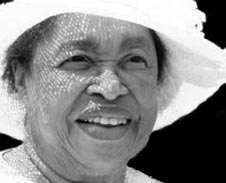This content is being reviewed in light of recent changes to federal guidance.
A Poetic Journey
 Once in the 1970s when I was driving E. Ethelbert Miller and a lady whose work got some attention in the early twentieth century to some event, the lady snidely remarked that Margaret Walker was a one-poem poet. A young man must respect his elders. I winced in silence. Literary history does reward snobbishness. The lady is as seldom mentioned for her plays and poetry as her once-famous father is mentioned for his contributions to African American intellectual history.
Once in the 1970s when I was driving E. Ethelbert Miller and a lady whose work got some attention in the early twentieth century to some event, the lady snidely remarked that Margaret Walker was a one-poem poet. A young man must respect his elders. I winced in silence. Literary history does reward snobbishness. The lady is as seldom mentioned for her plays and poetry as her once-famous father is mentioned for his contributions to African American intellectual history.
The one-poem poet, on the other hand is an icon in American cultural history, and her iconic status does not rest on a single poem. This single poem, however, continues to have uncanny agency. In “The Journey of Margaret Walker’s ‘For MyPeople,” Howard Rambsy II sketched the publishing history of the poem. Publishing history tells us much about the politics of the literary marketplace and much more about why ordinary people (who may have little or no vested interest in poetry as such) have embraced and “loved” Margaret Walker’s signature poem for over seven decades. Like James Weldon Johnson’s “Lift every Voice and Sing,” Claude McKay’s “If We Must Die,” and Langston Hughes’ “I Have Known Rivers,” the poem circulates and recirculates, providing succor in times of great need.
In addition to appearing in many anthologies, the poem appears in two special editions. One of the most handsome and expensive editions is For My People. New York: Limited Editions Club, 1992. It is an elephant folio with covers of red Japanese linen with black stamping, issued in 400 numbered copies. It contains lithographs by Elizabeth Catlett. The other special edition is Margaret Walker’s ‘For My People’: A Tribute (1992) with photographs by Roland L. Freeman.
In simple, carefully measured words, Gordon Parks wrote of this edition: “Roland Freeman’s tribute to Margaret Walker is indeed a beautiful merging of the talent both artists have displayed in literature and photography. Both are disciples of profound poetry.” Alferdteen Harrison reminds us in the preface that “the publishing relationship of Walker and Freeman, reflected in the present book, stands out as the first time a photography has published a photographic essay as a tribute to a poet”(8). Walker herself wrote on the next page: “I am grateful to Roland because I think he has the right concept — he understands the social significance of what I try to say. And therefore it pleases me very much” (9).
This aesthetic phenomenon elicits nostalgia for the once useful myth of a unified “black community” in the United States. Post-Civil Rights discourses (post-Black Arts, post-Soul, post-hip hop, post-human, post-signifier and significance) have figuratively and literally killed the myth. The myth is a diachronic narrative. We have no single “black community.” We have black communities which are feverishly POSTING themselves. The possible joy of flesh and blood, face-to-face communication is retreating, is almost completely displaced by the hoo doo of technology which nurtures the silence of the virtual. “For My People” will continue its journey and have aesthetic meaning and social significance for ordinary people/ cool outlaws who refuse to become willing slaves of advanced technology. “For My People” is a poem for the cool who survive.